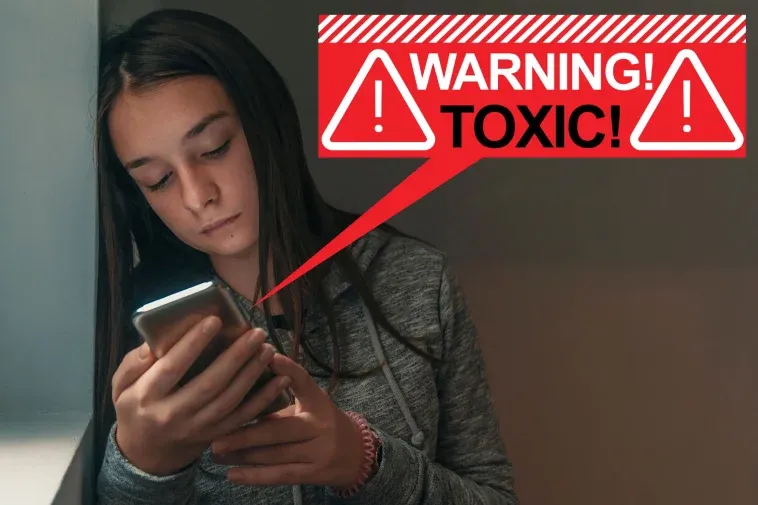(New York Post) Suzie* was a typical 22-year-old recent college grad from the Midwest who was admitted into my mental health clinic in Austin with a variety of increasingly common psychiatric disorders: depression, self-harm (cutting her arms) and a Borderline Personality Disorder (BPD) diagnosis. BPD is a serious personality disorder that has 50 times the suicide rate of the general population and is typified by black and white thinking, self-harm behavior, emotional volatility, impulsive behavior, shifting self-image and feelings of “emptiness.”
While Susie did initially present with some of the classic BPD symptoms (feeling empty and suicidal), something didn’t add up. Unlike most BPD clients, she didn’t have any of the early red flags; she had good grades and many friends in high school with stable relationships and a stable home environment — and no history of mental illness in her family.
 A screenshot of a TikTok page with the hashtag “borderline personality disorder” (BPD). The rise of BPD influencers and posts has led to an epidemic of youths self-diagnosing themselves with the condition.
A screenshot of a TikTok page with the hashtag “borderline personality disorder” (BPD). The rise of BPD influencers and posts has led to an epidemic of youths self-diagnosing themselves with the condition.
During Suzie’s treatment, we discovered the real culprit: she’d been spending 12-15 hours a day on Instagram, TikTok and YouTube after becoming depressed when her friends went away to university while she stayed home and attended community college. Initially trying to better understand her depression, she started to follow BPD influencers and joined online BPD groups, where she said that she felt a sense of belonging. Slowly and unwittingly, she started emulating what she was learning about BPD online — like cutting her arms after watching videos of influencers declare that cutting helped them feel in control — or at least “feel something.”
Suzie admitted that she never liked cutting herself but did it because she thought that it might eventuallyoffer her relief. And starved for a true identity, she also stated that the cutting and irrational behaviors that the influencers engaged in “made them interesting and authentic,” which she found appealing. By the time she was ready to admit into treatment, she had lost all her friends and spent her days and nights alone and online being shaped by her newly found BPD community.
 We are living in the age of Digital Social Contagion, in which many illnesses are spread by social media rather than biological agents. Isolation from COVID has only made the problem worse.Shutterstock
We are living in the age of Digital Social Contagion, in which many illnesses are spread by social media rather than biological agents. Isolation from COVID has only made the problem worse.Shutterstock
But something quite amazing happened while she was in treatment; she got better very quickly once all her devices and social media were removed. Within two weeks, she was calmer and less reactive; she made friends in the program; she no longer cut her arms and all thoughts of suicide evaporated. But if she really had BPD, she shouldn’t have been “cured” that quickly; clients with real BPD typically require many months or even years of treatment before seeing improvement. So what was really happening?
We’re living in the Age of Digital Social Contagions. It’s a time where certain illnesses aren’t spread by biological transmission, but by a digital infection that attacks the psychological immune system. Using algorithms that find and exploit our psychological vulnerabilities, we get sicker as Big Tech gets stronger.
 Lisa Littman, a physician-scientist at Brown University, has charted the correlation between social media exposure and the rise of previously rare disorders such as gender dysphoria.Twitter
Lisa Littman, a physician-scientist at Brown University, has charted the correlation between social media exposure and the rise of previously rare disorders such as gender dysphoria.Twitter
And make no mistake: we are getting sicker as a society, with record rates of depression, suicide, loneliness, overdoses, anxiety, addiction, emptiness, gender dysphoria and mass shootings that are disproportionately impacting teens and young adults, all made worse by the isolation and fear during COVID.
Beyond just the depression of living sedentary, isolated lives, we have the congressional testimony of Frances Haugen, The Facebook Whistleblower, who shared internal emails that showed Instagram’s own research indicated that their product increased suicidality in teenage girls and worsened their eating disorders. It seems that being exposed to a constant torrent of toxic content and comparing ourselves to the curated faux-glamor of vapid and shallow influencers isn’t good for the psyche — but it’s even worse than this much-researched and toxic “social comparison effect.”
 Corey Johnson is serving life in prison after becoming so warped by ISIS videos on social media that he stabbed a child to death.Palm Beach Gardens Police Department
Corey Johnson is serving life in prison after becoming so warped by ISIS videos on social media that he stabbed a child to death.Palm Beach Gardens Police Department
 Johnson sliced open the throat of his victim, Jovanni A. Sierra (above), after the 13-year-old made comments he deemed “offensive to Islam.” Two other victims were stabbed during the melee at a 2018 sleepover.GoFundMe
Johnson sliced open the throat of his victim, Jovanni A. Sierra (above), after the 13-year-old made comments he deemed “offensive to Islam.” Two other victims were stabbed during the melee at a 2018 sleepover.GoFundMe
Followers and views are the coin of the realm in the social-media hierarchy, and extreme content is what attracts that priceless human commodity: our attention. That’s why it’s the most over-the-top content and influencers that attract followers like moths to a lethal digital flame. And it’s also why we’re seeing dramatic spikes in once-rare disorders like Tourette Syndrome, Dissociative Identity Disorder (DID, formerly known as Multiple Personality Disorder) and Borderline Personality Disorder (BPD). These disorders are now being injected into our collective consciousness via popular TikTok and Instagram “influencers” who’ve racked up hundreds of millions of views — and have left a wake of young followers like Suzie who, consciously or unconsciously, are indeed “influenced” as they emulate the psychiatric symptoms of their mentally unwell social media darlings.
This social-contagion group effect shouldn’t come as a shock; for thousands of years we’ve seen it shape human behavior; from donning tribal war paint, to smoking cigarettes, to following your favorite sports team or joining a political movement. We’re social animals hard-wired to mimic and emulate one another. The only difference now that social media has swallowed up our world is that the impact of toxic and digitally spread behaviors are greatly magnified as they go viral.
 A TikTok page focused on “multiple personality disorder” — yet another condition made popular by influencers whose posts are getting millions of views.
A TikTok page focused on “multiple personality disorder” — yet another condition made popular by influencers whose posts are getting millions of views.
Although we now know that social media is harmful to our mental health, we can’t seem to stop. Like a cirrhotic alcoholic, the health consequences be damned when you compulsively need another drink — or tweet. And the more of the digital toxin that we consume, the weaker and more compromised our psychological immune system becomes, making us even more vulnerable for further consumption, manipulation and behavior modification.
The Big Tech social media playbook is a simple three step process. Step 1: Create habituation. Use the most sophisticated algorithm-fueled behavior mod techniques to create dependency.
 Whistleblower Frances Haugen exposed internal Instagram research showing a link between the platform and increased bulimia and suicidal tendencies in teenage girls.Getty Images for Vox Media
Whistleblower Frances Haugen exposed internal Instagram research showing a link between the platform and increased bulimia and suicidal tendencies in teenage girls.Getty Images for Vox Media
Step 2: Once addicted, the person’s psychological immune system begins to erode. As in any addiction, this is the realm of depression, hopelessness and a sense of emptiness — an emptiness that can only be temporarily filled by more of the toxin.
Step 3: Once weakened and addicted, a person is now susceptible to any number of manipulations; these include further addiction, ideological brainwashing, identity shaping and, sadly, an encroachment into the once hallowed ground of our thoughts. Free no more.
The 1999 Columbine school shooting was the first in the digital age (such events had been almost unheard of before then). Since then, they have become a horrible part of daily life. However, even the FBI acknowledges that these are Internet-fueled copycat events; classic examples of a social contagion — spread and spawned on social media and hate-filled chat rooms that incite the unstable.
 Members of a popular TikTok page focused on Tourette Syndrome. Social media experts say pages like these can literally influence healthy young people to feel unwell.
Members of a popular TikTok page focused on Tourette Syndrome. Social media experts say pages like these can literally influence healthy young people to feel unwell.
This digital social contagion can also lead to ideological extremism. I was an expert witness this year in the capital murder trial of Corey Johnson in Florida, the white suburban teen radicalized by a nonstop stream of ISIS recruitment videos on YouTube. This year, he was sentenced to life in prison for stabbing a 13-year-old boy to death at a 2018 sleepover.
And, of course, we have the logic-defying spike in gender dysphoria; a spike that trans psychologist Erica Anderson, who has helped hundreds of teens transition, says “has gone too far.” According to Anderson, teens — who have always gone through periods of identity confusion and experimentation — are now being exposed to and impacted by social media and trans influencers. Dr. Anderson’s insights were confirmed by Dr. Lisa Littman’s research at Brown, which showed the social media impact on what she termed “late onset gender dysphoria.”
 Author and addiction expert Nicholas Kardaras’ new book chronicles the link between social media addiction and mental health woes. Rather than truly being ill, he says, many young people see pages about issues like BPD as a “place of belonging.”
Author and addiction expert Nicholas Kardaras’ new book chronicles the link between social media addiction and mental health woes. Rather than truly being ill, he says, many young people see pages about issues like BPD as a “place of belonging.”
Like BPD, gender dysphoria is a real psychological phenomenon that people genuinely struggle with. However, what we’re seeing now is something different. We’re seeing social media shaping people in ways that seem to mimic some of these disorders yet are not the genuine article. Several colleagues and I have begun to call them cases of pseudo-BPD, pseudo-DID or pseudo-Gender Dysphoria. These are cases where the presenting symptoms dissipate when the person is removed from social media for several weeks, thereby proving that the behaviors presented are not the genuine disorder.
Instead of genuine mental illness, many of our young people are simply attempting to find a tribe or community to belong to via their online explorations and demonstrating what psychologists call “sociogenic” effects; that is, effects caused by social forces — in this case, digital social forces.

What I believe we desperately need is to better understand these powerful shaping effects of social media and to help young people develop a strong psychological immune system and critical thinking skills in order to navigate the rough and turbulent seas of today’s social-media world.
*This patient’s name has been changed.
Dr. Nicholas Kardaras is the Founder and Chief Clinical Officer of Omega Recovery in Austin, Texas and Maui Recovery in Hawaii. A former clinical professor at Stony Brook Medicine, he’s the bestselling author of “Glow Kids” and his latest book “Digital Madness: How Social Media is Driving Our Mental Health Crisis — and How to Restore our Sanity” (St. Martin’s) is out now.






